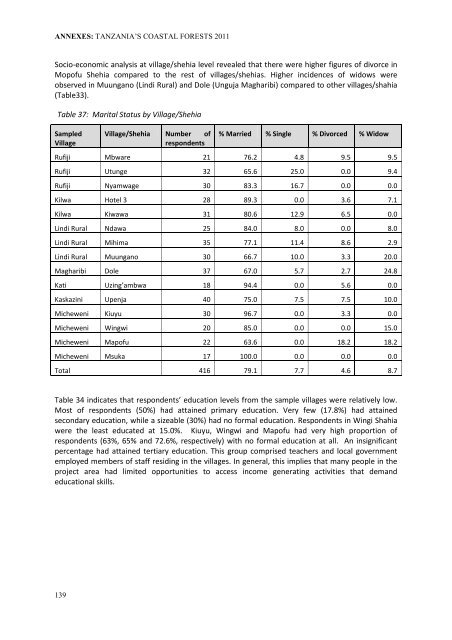Neil D. Burgess, Paul Harrison, Peter Sumbi, James Laizer, Adam ...
Neil D. Burgess, Paul Harrison, Peter Sumbi, James Laizer, Adam ...
Neil D. Burgess, Paul Harrison, Peter Sumbi, James Laizer, Adam ...
Create successful ePaper yourself
Turn your PDF publications into a flip-book with our unique Google optimized e-Paper software.
ANNEXES: TANZANIA’S COASTAL FORESTS 2011<br />
Socio-economic analysis at village/shehia level revealed that there were higher figures of divorce in<br />
Mopofu Shehia compared to the rest of villages/shehias. Higher incidences of widows were<br />
observed in Muungano (Lindi Rural) and Dole (Unguja Magharibi) compared to other villages/shahia<br />
(Table33).<br />
Table 37: Marital Status by Village/Shehia<br />
Sampled<br />
Village<br />
Village/Shehia Number of<br />
respondents<br />
% Married % Single % Divorced % Widow<br />
Rufiji Mbware 21 76.2 4.8 9.5 9.5<br />
Rufiji Utunge 32 65.6 25.0 0.0 9.4<br />
Rufiji Nyamwage 30 83.3 16.7 0.0 0.0<br />
Kilwa Hotel 3 28 89.3 0.0 3.6 7.1<br />
Kilwa Kiwawa 31 80.6 12.9 6.5 0.0<br />
Lindi Rural Ndawa 25 84.0 8.0 0.0 8.0<br />
Lindi Rural Mihima 35 77.1 11.4 8.6 2.9<br />
Lindi Rural Muungano 30 66.7 10.0 3.3 20.0<br />
Magharibi Dole 37 67.0 5.7 2.7 24.8<br />
Kati Uzing’ambwa 18 94.4 0.0 5.6 0.0<br />
Kaskazini Upenja 40 75.0 7.5 7.5 10.0<br />
Micheweni Kiuyu 30 96.7 0.0 3.3 0.0<br />
Micheweni Wingwi 20 85.0 0.0 0.0 15.0<br />
Micheweni Mapofu 22 63.6 0.0 18.2 18.2<br />
Micheweni Msuka 17 100.0 0.0 0.0 0.0<br />
Total 416 79.1 7.7 4.6 8.7<br />
Table 34 indicates that respondents’ education levels from the sample villages were relatively low.<br />
Most of respondents (50%) had attained primary education. Very few (17.8%) had attained<br />
secondary education, while a sizeable (30%) had no formal education. Respondents in Wingi Shahia<br />
were the least educated at 15.0%. Kiuyu, Wingwi and Mapofu had very high proportion of<br />
respondents (63%, 65% and 72.6%, respectively) with no formal education at all. An insignificant<br />
percentage had attained tertiary education. This group comprised teachers and local government<br />
employed members of staff residing in the villages. In general, this implies that many people in the<br />
project area had limited opportunities to access income generating activities that demand<br />
educational skills.<br />
139

















